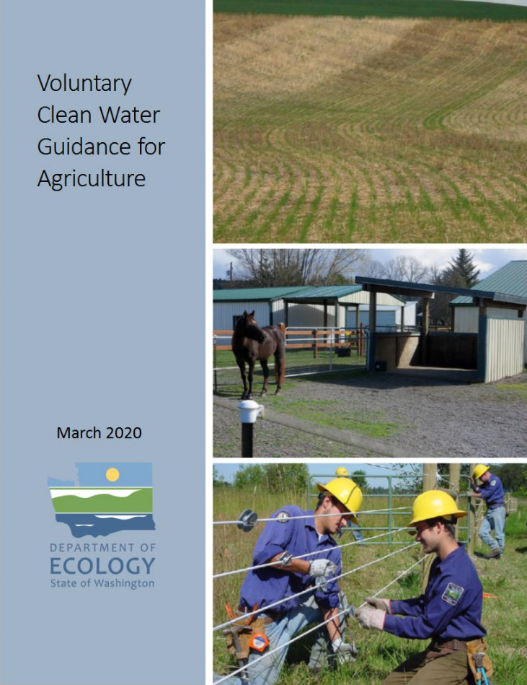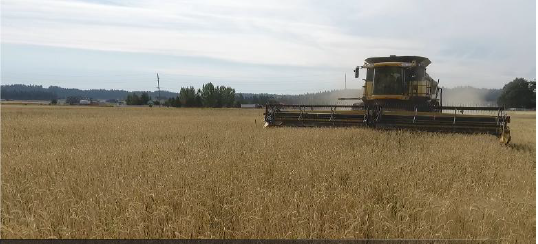We recently released the first draft chapter of the Voluntary Clean Water Guidance for Agriculture. The 13-chapter guidance is a technical resource for agricultural producers that describes our recommended best management practices (BMPs) to protect water quality. Our goal is to support healthy farms and help farmers meet clean water quality standards. We understand that each farm is unique and each producer is managing a differing set of site, soil, and climate factors. We wrote this guidance to help producers identify the BMPs and implementation strategies that best fit their farm’s needs.
Conservation practices covered in the guidance
The Voluntary Clean Water Guidance will cover an variety of conservation practices.
The first chapter, Cropping Methods: Tillage and Residue Management, outlines our recommended BMPs for tillage and residue management. The BMPs focus on ways to minimize soil loss from fields and retain healthy soil. Many of these practices have co-benefits such as controlling pollution, improving soil health, and many practices become less expensive over time.
We will develop the next 12 chapters with ongoing collaboration with our advisory group. Each chapter will address a different type of conservation practice, such as:
- Crop system
- Nutrient management
- Pesticide management
- Sediment control
- Water management
- Livestock management
- Riparian areas and surface water protection
Eventually, we will incorporate the guidance chapters into Washington's Water Quality Management Plan to Control Nonpoint Sources of Pollution.
Who helped write the guidance?
The Guidance addresses different tillage and residue recommendations depending on the crop. Potatoes, for example, are lower residue crops and may require different conservation practices.
We worked closely with an Advisory Group to develop the guidance. The group includes representatives from the National Resource Conservation Service (NRCS), Conservation Districts, the Washington Department of Agriculture, State Conservation Commission, Washington State University, agriculture producer groups, environmental groups, the Environmental Protection Agency, the Washington Department of Fish and Wildlife, and the Northwest Indian Fisheries Commission.
Over the next few years, we will continue to work with the advisory group to write the next chapters, asking for public feedback along the way.
What does “voluntary” mean?
Agricultural producers must comply with state water quality laws, but there are many options for how producers can protect water quality.
This guidance is voluntary because it is not required that agricultural producers use these specific BMPs. The guidance does not create new regulatory requirements and does not prescribe a single approach or set of practices for all farms. Producers still get to choose how to achieve compliance with water quality laws, about whether to implement recommended BMPs, and about which practices to choose. If producers use our recommended BMPS, we will presume that producer is adequately protecting water quality.
Chapter 1 of the Guidance addresses different types of tillage practices and recommends BMPs for tillage based on differing production factors.
How we will use the guidance
We wrote this guidance for many audiences: our own staff, farmers and landowners, and conservation districts.
Department of Ecology
We plan to use the guidance as a resource for pollution prevention planning. This guidance will help us:
- Make funding decisions for grant programs
- Inform watershed cleanup plans
- Provide technical assistance, education,and outreach
Farmers and landowners
We recommend farmers use this during the farm planning process and as they decide which BMPs to use on their land.
Conservation districts and other natural resource related program
This guidance can help inform the water quality protection projects and support recommendations to landowners on how to manage their land. It can also serve as a tool for developing education and outreach materials.
We welcome your feedback
You may submit feedback on draft chapters as we work towards finalizing the guidance. To provide feedback on Chapter 1: Cropping Methods: Tillage and Residue Management please go to our comment webpage:
Voluntary Clean Water Guidance Comment Form
We will use this same page to collect comments on all of the draft chapters we release this year. We can accept comments on each individual chapter or comments on multiple chapters at once. We plan to provide drafts of the following chapters this year:
- Riparian Areas & Surface Water Protection (Buffers)
- Livestock Management: Pasture & Rangeland Grazing
- Livestock Management: Animal Confinement, Manure Handling & Storage
- Suites of Recommended Practices.
We will not finalize the chapters until after receiving feedback on all the chapters released this year.
For more information on the guidance or its creation process, please contact Ben Rau, ben.rau@ecy.wa.gov.




